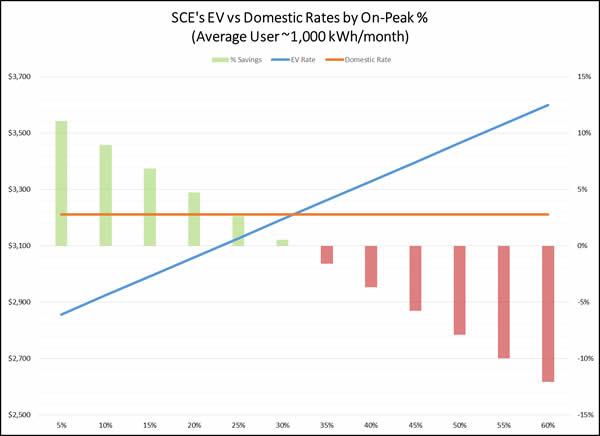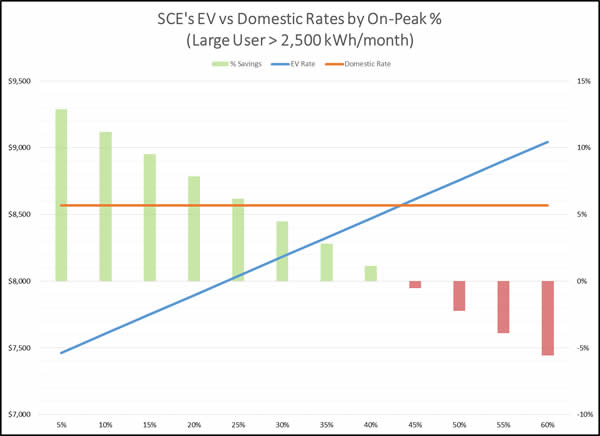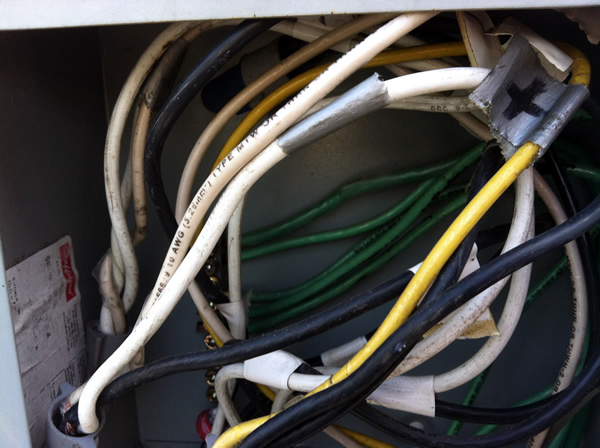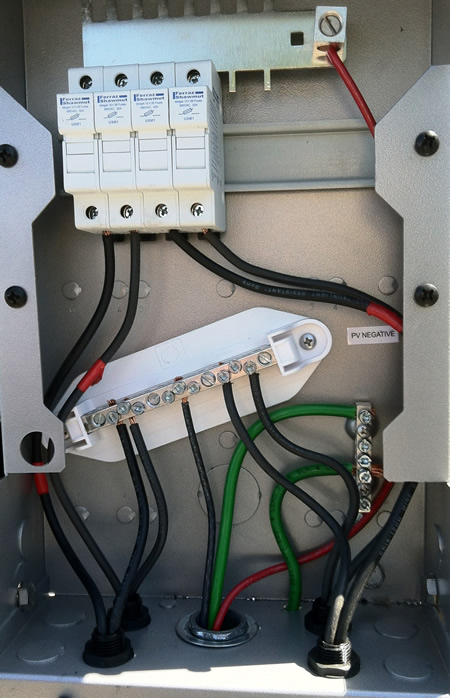Welcome to the
Run on Sun Monthly Newsletter

In this Issue: |
May, 2014
Volume: 5 Issue: 5
SCE's EV vs Domestic Rates - Driver Beware!SCE has devised an extremely complicated rate structure designed for residential customers who drive electric vehicles. Instead of having a separate meter for EV charging, this rate structure is designed to replace the Domestic rate and apply to the entire household's energy use—presumably at a savings. But does it? What we discovered may come as a shock. Meet TOU-D-TEVSCE has long offered a rate structure that was designed for separate meter charging of EVs. But as more and more people acquire EVs there were relatively fewer consumers looking to go through the hassle of installing a separate meter just to charge their EV. SCE's combined household and EV charging rate, known by the unmelodious monicker of TOU-D-TEV ("EV Rate," for short), is designed to provide a lower-cost option for customers who were previously on SCE's standard, Domestic rate structure. As the acronym implies, the EV Rate is a time-of-use rate structure which means that what you pay for a kilowatt-hour of energy is directly tied to when you use it. There are three time classes: On-Peak (weekdays, excluding designated holidays, from 10 a.m. to 6 p.m.), Super Off-Peak (everyday, midnight to 6 a.m.) and Off-Peak (all other times). In addition to the time of use component, the EV Rate includes tiers. While Domestic rate customers are used to four tiers at which energy gets progressively more expensive, the EV Rate has only two tiers. Put this all together and you have the potential to pay wildly different amounts for your energy, as the EV Rate structure table shows. Stay within Level 1 and use your energy during Super Off-Peak and you pay just 9.4¢/kWh. But make the mistake of using energy during the middle of the day in the summer in Level 2 and you will be pay a shocking, 46.4¢/kWh! Yikes!!! Sure hope you aren't at home during the day running your A/C. So Why Switch?EV owners are not required to take service under the EV Rate structure (at least not yet), so why switch? SCE advises customers that they can save money using this rate and we wanted to see if that was really true. We decided to model two different users and see how their bills would change between the Domestic rate and the EV Rate. The first user, our "average" user, consumes roughly 1,000 kWh per month (probably on the low end for most EV owners), or a little more than twice the baseline allocation. The second user, our "large" user, consumes more like 2,500 kWh per month and reflects a large home with heavy A/C use. Let's start with the average user: This graph compares what our average user would have paid under SCE's Domestic rate (the constant, orange line) against what she would pay under the EV Rate (the blue line) as a function of what percentage of the total monthly usage occurs during On-Peak hours. (Throughout we assume that 20% occurs during the Super Off-Peak hours of midnight to 6 a.m., and the balance occurs during Off-Peak). Under the Domestic rate, our average customer would pay $3,200 for the year. If she manages to keep her On-Peak usage down below 30% of the total energy consumption, she will save money—as much as $355 or 11% off her bill, if her On-Peak usage is jut 5%. But those "savings" can quickly disappear if she isn't careful (or her children aren't). Let her On-Peak usage climb to 60% of her bill and she will get hit with a 12% penalty and end up paying $388 more than if she had not switched. What about our "large" user, how does he fare? Most likely, better. While his overall bill is much higher—he would be paying $8,500 on the Domestic rate—his potential savings versus penalty comparison is much more forgiving. He can save as much as 13% ($1,100) compared to a penalty of only 6% ($478). Plus, his break even point is higher, as he doesn't start losing money until his On-Peak usage gets to 45%. (This actually continues a trend with SCE's residential rates where increases are highest at the lowest end of usage and the very highest users are actually getting a bit of a break. What an odd sort of mixed message.) Bottom line—it is possible to save money, even significant money, if you are very careful about when you use energy. Most EVs are designed so that you can program them to charge during off-hours and anyone under this rate structure would absolutely want to insure that they use that feature. Indeed, there may be other energy users that could be similarly re-programmed such as pool pumps, dishwashers and washing machines, to run during the Super Off-Peak window. Unfortunately, it is very difficult to avoid running your A/C during the day if anyone is at home from 10 a.m. to 6 p.m. on weekdays—and doing so could be very expensive. Solar to the RescueIt should be obvious, but adding solar to the mix here could be huge since On-Peak hours directly coincide with the greatest production from a solar power system. Put most simply, if you own an EV and are considering making the switch to this EV rate structure, you need solar. |
“Put most simply, if you own an EV and are considering making the switch to this EV rate structure, you need solar…”
Get your copy of
Commercial Solar:
Step-by-Step
from
Run on Sun
Founder & CEO
Jim Jenal

Now available on Amazon.com
in both
Print & Kindle versions.
Bonus - Buy the Print version…
Get the
Kindle version for Free!
Commercial Solar:
Step-by-Step
from Run on Sun
Founder & CEO
Jim Jenal

Now available on Amazon.com
in both Print & Kindle versions.
Get the Kindle version for Free!
Help Us Spread the News!





How Safe is Your Solar Power System?Is your solar power system safe? How can you be sure? We are receiving more and more inquiries about fixing solar power systems from folks whose system has stopped working and the original installer can no longer be found. Sometimes a violent act of nature prompts the need for our services, but all too often we are seeing shoddy work that has failed far too soon. Case in point, we received a call from a true "rocket scientist" the other day who had a solar power system installed about seven years ago, but now he was having a problem. We learned that the system had been installed by an air conditioning company (you've seen their ads), and it had two SMA Sunny Boy 2800 inverters—now well out of warranty—and one of them was displaying the dreaded, ground fault error. Ground faults occur when a normally ungrounded, current-carrying conductor makes contact with something that is grounded, such as the frame of a solar module, the system racking or even the conduit itself. Ground faults can be dangerous and are often difficult to locate. When the solar system owner contacted his installation company, they offered to replace his offline inverter—for $5,000! Of course, simply replacing the inverter was unlikely to do anything about the ground fault, and it was possible that there was nothing wrong with the inverter at all, apart from being out of warranty. But in any event, charging $5,000 to simply do a one-for-one inverter replacement was highway robbery, and the system owner was pretty annoyed by the time he got around to calling us. Since there was no way to properly diagnose the situation over the phone, we agreed to come out and take a look. Sure enough, one of the inverters was working fine, but the other displayed a ground fault message. The system owner told us that there was a combiner box on the roof, so we headed there to try and figure out where the fault might be. Here's what we found in that "combiner box": People can get hurt this way. Property can be destroyed this way. And the solar industry can get a very bad reputation this way. We broke the bad news to the system owner and explained that what was needed was to replace the box on the roof with a proper combiner box, replace the improper wiring with USE-2 wiring that is designed to last on a roof, and bring the system back online. We also suggested that given that his existing inverters were out of warranty, he might want to consider upgrading to a single, transformerless inverter that would provide a ten-year warranty, the possibility of online monitoring, and much greater efficiency. That was the path he decided to take. We installed an Outback combiner and upgraded the wiring. In so doing we managed to bring some order out of the previous chaos, take a look: Moral of the StoryThere are a number of take aways from this experience that we would like to stress:
|
Los Angeles County Gets HERO FinancingWe have been waiting quite a while, but the good news is that HERO Financing for residential solar has finally arrived in Los Angeles County! On Friday, May 23, the HERO Financing program formally launched in LA County after being a huge success in Riverside and San Bernardino counties, helping fuel explosive growth of solar installations in those counties. Here is how they describe the program:
Unfortunately, not every city in LA County is (presently) participating—most notable laggard from our perspective? Pasadena! Come on, Pasadena, what is up with this? Pasadena was signed on to the PACE program years ago, so what is holding you back now? (Oh, and the City of LA is not signed on yet either, but no shock there.) Here is the list of participating cities in LA County as of the program rollout:
If you would like to encourage Pasadena to get with the program, here is some contact information for you:
|





